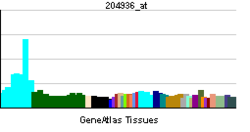MAP4K2
Mitogen-activated protein kinase kinase kinase kinase 2 is an enzyme that in humans is encoded by the MAP4K2 gene.[1][2]
The protein encoded by this gene is a member of the serine/threonine protein kinase family. Although this kinase is found in many tissues, its expression in lymphoid follicles is restricted to the cells of germinal centre, where it may participate in B-cell differentiation. This kinase can be activated by TNF-alpha, and has been shown to specifically activate MAP kinases. This kinase is also found to interact with TNF receptor-associated factor 2 (TRAF2), which is involved in the activation of MAP3K1/MEKK1.[2]
Interactions
MAP4K2 has been shown to interact with RAB8A[3] and TRAF2.[4]
References
- ↑ Katz P, Whalen G, Kehrl JH (Jul 1994). "Differential expression of a novel protein kinase in human B lymphocytes. Preferential localization in the germinal center". J Biol Chem 269 (24): 16802–9. PMID 7515885.
- ↑ 2.0 2.1 "Entrez Gene: MAP4K2 mitogen-activated protein kinase kinase kinase kinase 2".
- ↑ Ren, M; Zeng J, De Lemos-Chiarandini C, Rosenfeld M, Adesnik M, Sabatini D D (May 1996). "In its active form, the GTP-binding protein rab8 interacts with a stress-activated protein kinase". Proc. Natl. Acad. Sci. U.S.A. (UNITED STATES) 93 (10): 5151–5. doi:10.1073/pnas.93.10.5151. ISSN 0027-8424. PMC 39423. PMID 8643544.
- ↑ Yuasa, T; Ohno S; Kehrl J H; Kyriakis J M (Aug 1998). "Tumor necrosis factor signaling to stress-activated protein kinase (SAPK)/Jun NH2-terminal kinase (JNK) and p38. Germinal center kinase couples TRAF2 to mitogen-activated protein kinase/ERK kinase kinase 1 and SAPK while receptor interacting protein associates with a mitogen-activated protein kinase kinase kinase upstream of MKK6 and p38". J. Biol. Chem. (UNITED STATES) 273 (35): 22681–92. doi:10.1074/jbc.273.35.22681. ISSN 0021-9258. PMID 9712898.
Further reading
- Vionnet N, Stoffel M, Takeda J et al. (1992). "Nonsense mutation in the glucokinase gene causes early-onset non-insulin-dependent diabetes mellitus". Nature 356 (6371): 721–2. doi:10.1038/356721a0. PMID 1570017.
- Matsutani A, Janssen R, Donis-Keller H, Permutt MA (1992). "A polymorphic (CA)n repeat element maps the human glucokinase gene (GCK) to chromosome 7p". Genomics 12 (2): 319–25. doi:10.1016/0888-7543(92)90380-B. PMID 1740341.
- Pombo CM, Kehrl JH, Sánchez I et al. (1995). "Activation of the SAPK pathway by the human STE20 homologue germinal centre kinase". Nature 377 (6551): 750–4. doi:10.1038/377750a0. PMID 7477268.
- Ren M, Zeng J, De Lemos-Chiarandini C et al. (1996). "In its active form, the GTP-binding protein rab8 interacts with a stress-activated protein kinase". Proc. Natl. Acad. Sci. U.S.A. 93 (10): 5151–5. doi:10.1073/pnas.93.10.5151. PMC 39423. PMID 8643544.
- Guru SC, Agarwal SK, Manickam P et al. (1997). "A Transcript Map for the 2.8-Mb Region Containing the Multiple Endocrine Neoplasia Type 1 Locus". Genome Res. 7 (7): 725–35. doi:10.1101/gr.7.7.725. PMC 310681. PMID 9253601.
- Yuasa T, Ohno S, Kehrl JH, Kyriakis JM (1998). "Tumor necrosis factor signaling to stress-activated protein kinase (SAPK)/Jun NH2-terminal kinase (JNK) and p38. Germinal center kinase couples TRAF2 to mitogen-activated protein kinase/ERK kinase kinase 1 and SAPK while receptor interacting protein associates with a mitogen-activated protein kinase kinase kinase upstream of MKK6 and p38". J. Biol. Chem. 273 (35): 22681–92. doi:10.1074/jbc.273.35.22681. PMID 9712898.
- Chadee DN, Yuasa T, Kyriakis JM (2002). "Direct Activation of Mitogen-Activated Protein Kinase Kinase Kinase MEKK1 by the Ste20p Homologue GCK and the Adapter Protein TRAF2". Mol. Cell. Biol. 22 (3): 737–49. doi:10.1128/MCB.22.3.737-749.2002. PMC 133545. PMID 11784851.
- Strausberg RL, Feingold EA, Grouse LH et al. (2003). "Generation and initial analysis of more than 15,000 full-length human and mouse cDNA sequences". Proc. Natl. Acad. Sci. U.S.A. 99 (26): 16899–903. doi:10.1073/pnas.242603899. PMC 139241. PMID 12477932.
- Wissing J, Jänsch L, Nimtz M et al. (2007). "Proteomics analysis of protein kinases by target class-selective prefractionation and tandem mass spectrometry". Mol. Cell Proteomics 6 (3): 537–47. doi:10.1074/mcp.T600062-MCP200. PMID 17192257.
